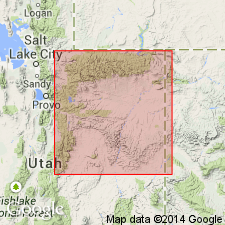
- Usage in publication:
-
- Coon Spring Sandstone Bed*
- Modifications:
-
- Named
- Dominant lithology:
-
- Sandstone
- Shale
- AAPG geologic province:
-
- Uinta basin
- Paradox basin
Summary:
Named as a sandstone bed in middle part of Tununk Member of Mancos Shale. Type section measured in SE1/4 sec 24, T17S, R13E, Emery Co, UT, Paradox basin. Named for Coon Spring in NE1/4 sec 3, T17S, R13E. Consists of basal gray, very fine grained, silty and argillaceous bioturbated sandstone succeeded upwards by 1) gray-black clayey shale and siltstone, 2) gray, very fine to fine grained, silty, poorly bedded, burrowed, fossiliferous sandstone, 3) gray-white, medium- to fine-grained, well-sorted, flat to cross-bedded ledge-forming sandstone that total 45 ft thick at type where Coon Spring is underlain by unnamed dark-gray siltstone, lower part of Tununk and overlain by unnamed gray very fine to fine grained, poorly bedded bioturbated sandstone, upper part of Tununk. Basal contact transitional with lower Tununk. Cross sections. Correlation chart. Recognized in UT from Farnham dome, Carbon Co, Uinta basin south to through Emery Co east to Thompson, Grand Co, Paradox basin, and north into Uintah Co, Uinta basin on the surface and in the subsurface. Abundant sandstone concretions in upper part contain COLLIGNONICERAS WOOLLGARI, an early middle Turonian guide fossil, and guide fossils EXOGYRA and PINNA. Deposited during a shoaling of the sea.
Source: GNU records (USGS DDS-6; Denver GNULEX).
For more information, please contact Nancy Stamm, Geologic Names Committee Secretary.
Asterisk (*) indicates published by U.S. Geological Survey authors.
"No current usage" (†) implies that a name has been abandoned or has fallen into disuse. Former usage and, if known, replacement name given in parentheses ( ).
Slash (/) indicates name conflicts with nomenclatural guidelines (CSN, 1933; ACSN, 1961, 1970; NACSN, 1983, 2005, 2021). May be explained within brackets ([ ]).

